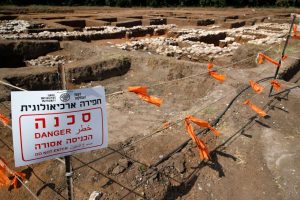OCTOBER 7, 2019
 A picture taken on October 06, 2019, shows a warning sign and safety cordons at the archaeological site of En Esur (Ein Asawir) where a 5000-year-old city was uncovered, near the Israeli town of Harish. – Jack Guez/Getty
A picture taken on October 06, 2019, shows a warning sign and safety cordons at the archaeological site of En Esur (Ein Asawir) where a 5000-year-old city was uncovered, near the Israeli town of Harish. – Jack Guez/Getty
Archaeologists have uncovered a 5,000-year-old city thought to be ten times larger than Jericho as well as a 7,000-year-old temple in northern Israel, officials announced Sunday.
The city, En Esur, was located in what is now Israel’s Haifa District. It was uncovered across two and half years by professional archaeologists of the Israel Antiquities Authority (IAA) as well as volunteers, some of whom were teenagers, according to United Press International.
Representatives of the IAA described the newly excavated city, located in Israel’s Haifa District, as the region’s “Early Bronze Age New York.” It spanned over 160 acres and is estimated to have had 6,000 inhabitants. While smaller than contemporaneous cities in Mesopotamia and Egypt, En Esur would have dwarfed the more well-known cities of Megiddo and Jericho in southern Israel, according to Haaretz.
Not only was En Esur large in its heyday compared to other ancient Levantine cities, but it was also intricately planned, Haaretz reported. It had large silos designed for efficient food storage, and the roads of its intricate network of streets were covered with plaster and stones to help prevent flooding.
“There is no doubt that this site dramatically changes what we know about the character of the period and the beginning of urbanization of Israel,” said Israel Antiquities Authority directors and Dr. Dina Shalem Dr. Yitzhak Paz in a statement.
“By the end of the fourth millennium B.C.E., the site became a city. It is one of the earliest cities known in the southern Levant, and it is the largest by far,” Paz told Haaretz.
While excavating the city’s ancient houses, archaeologists also found a religious temple that they have concluded is about 2,000 years older than the city.
They uncovered objects that would have been used in several religious rituals, including charred animal bones probably used in sacrifices, and a large stone basin that was used to hold liquids. Haaretz reported that some of these stone basins weighed between 10 and 15 tons and would have had to been quarried and carried from a site miles away — evincing the care and effort put into the development of En Esur.
Other human-made objects, including millions of pottery fragments and flint tools, were also discovered at the site, according to UPI.
“These surprising findings allow us, for the first time, to define the cultural characteristics of the inhabitants of this area in ancient times,” the Israel Antiquities Authority said.
Despite the importance of the findings, the site is still planned to disappear under a new road junction, Haaretz reported.
The Israel Antiquities Authority, which conducted the dig, described itself on its website as “the pre-eminent organization in the field of Israeli archaeology.” The organization is responsible for all archaeology in Israel, including the conservation of objects and sites. It protects over 30,000 archaeological sites and boasts two million artifacts in Israel’s State Treasures collection, which includes the Dead Sea Scrolls.










































































































